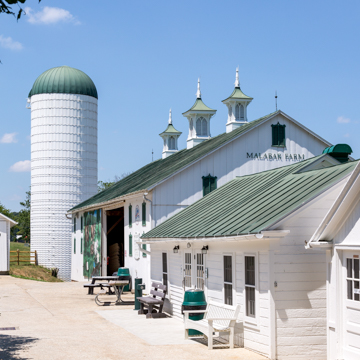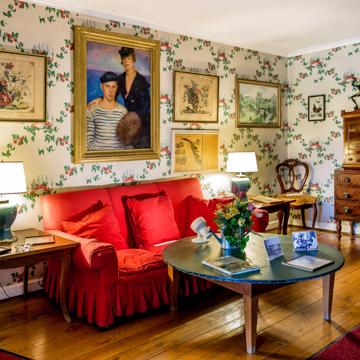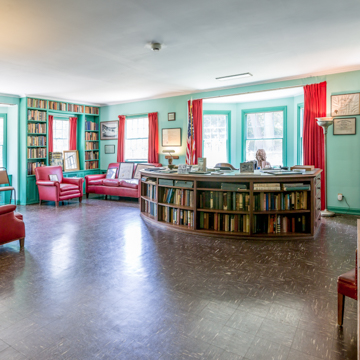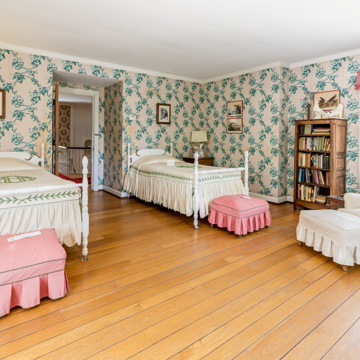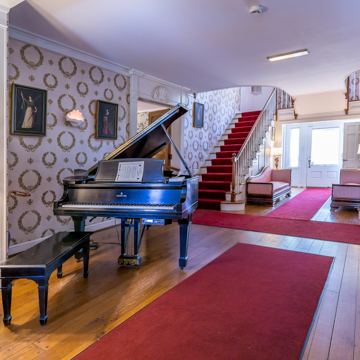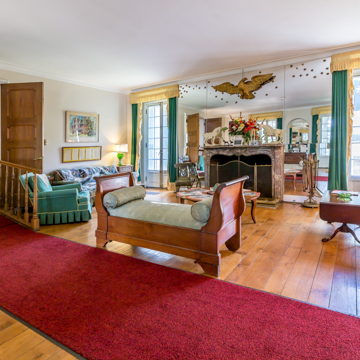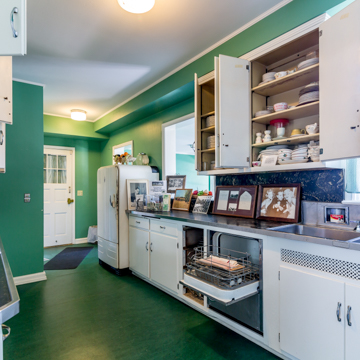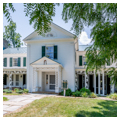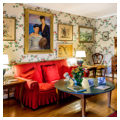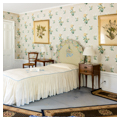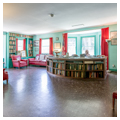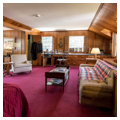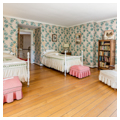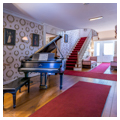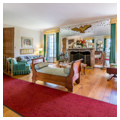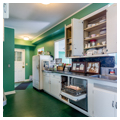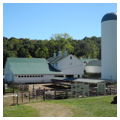Malabar Farm is the home of Pulitzer Prize–winning Ohio author Louis Bromfield (1896–1956). Its centerpiece is the Big House, a twentieth-century country house built around a nineteenth-century farmhouse and designed to look as if it had been added to over time by successive owners. To create this house, Bromfield hired Louis Lamoreux of nearby Mansfield, whom he described as an “architect of good taste who knew his Ohio countryside and his Ohio architecture.” Collaborating with Lamoreux was I.T. Frary, author of the 1936 book Early Homes of Ohio and the state’s leading expert on early Ohio architecture. Bromfield, Lamoreux, and Frary studied the features of early Ohio buildings in order to replicate their details in the Big House. Shortly after it was completed, the Big House hosted the wedding of Humphrey Bogart and Lauren Bacall in 1945.
Bromfield was born in 1896 and grew up in Mansfield in Richland County, where his family had been among the earliest white settlers and farmers. Bromfield’s first novel, The Green Bay Tree, was published in 1924 and his third novel, Early Autumn, won him a Pulitzer Prize and made him one of America’s most promising young authors, at the age of thirty. Bromfield’s early novels addressed themes of his youth: the loss of an agrarian ideal to dehumanizing industrialization, the deterioration of farmland, and rampant development of the countryside. Between 1925 and 1938, Bromfield lived in France with his wife, Mary, and their three daughters. While living abroad, Broomfield published The Farm, a fictionalized autobiography celebrating a farm family’s lifestyle and values in the pre-industrialized Ohio countryside. With the onset of World War II, Bromfield returned to the valley of his childhood to pursue his lifelong interest in farming. Once settled in Richland County, he began practicing then new farming techniques of rotating crops and using organic fertilizers. After he sold movie rights to The Rains Came, his 1937 bestselling novel set in India, he purchased several rundown farms and renamed them Malabar, after the historic region on India’s southwest coast.
Situated on a ledge overlooking Pleasant Valley, Malabar Farm originally included 595 acres and its entrance was south of the Big House off Bromfield Road (State Highway 438). Immediately northeast of the house across a farm lane are the barn, silo, and several additional farm structures. To their east, the farm yard opens onto rolling pastures and fields. The current timber-frame bank barn was built in 1994 after the original barn was destroyed by fire the previous year. Several newer buildings for state park visitors’ use are clustered around parking lots north of the house and farm yard. The main entrance is now located off of Pleasant Valley Road near this group of buildings.
The Big House was realized just as Bromfield imagined it, as an homage to Ohio’s early buildings. With Frary’s advice, Lamoreux copied architectural details from structures dating from early statehood to the pre–Civil War era, and from north, south, east, and western Ohio. The two-story gabled entrance with a portico is based on the 1821 Peter Allen House in Kinsman, and it replicates its scale and proportions. The portico lunette is based on a similar feature found in a house in Twinsburg. The two porches with cast-iron trellises decorated with grapes and leaves were based on a house in the Ohio River town of Marietta. The trellis detail on the east entrance was borrowed from the 1835 James Nicholson House in Lakewood, near Cleveland. The dormer windows in the north wing are derived from those of the 1833 Inn at Zoar, a community of German separatists in northeast Ohio. Other features were based upon trim, window and door surrounds, and cornice details from the 1820 Baum-Taft House in Cincinnati, the 1829 Mathews House in Painesville, and an 1832 house in Norwalk.
The resulting house has thirty-two rooms with seven bedrooms and five baths, and it reflects both Bromfield’s idealized vision of farm life and the practical needs of a large and active family that entertained many guests. Life at Malabar reflected Bromfield’s dual existence as a farmer and writer, not only of bestselling novels but also Hollywood screenplays, and he regularly hosted friends from his literary circles and Hollywood movie stars along with local farmers, ladies clubs, and state politicians.
Today, the still-functioning farm is operated by the Ohio Department of Natural Resources as state park. The farm is listed on the National Register and it interprets Bromfield’s literary life and his farming practices and theories on soil conservation.
References
Bromfield, Louis. The Farm. 1933. Reprint, New York: W.W. Norton, 1985.
Bromfield, Louis. Pleasant Valley. 1943. Reprint, New York: Harper and Brothers Publishers, 1945.
Platt, Carolyn V. “Bromfield’s Farm.” Timeline13 (May/June) 1996: 36-54.
Powers, Barbara. “Louis Bromfield’s Big House at Malabar Farm, Form Follows Fiction.” In Re-creating the American Past, Essays on the Colonial Revival, edited by Richard Guy Wilson, Shaun Eyring, and Kenny Marotta, 303-317. Charlottesville: University of Virginia Press, 2006.
Wilson, Richard Guy. The Colonial Revival House. Photography by Noah Sheldon. New York: Harry N. Abrams, Inc., Publishers, 2004.





















